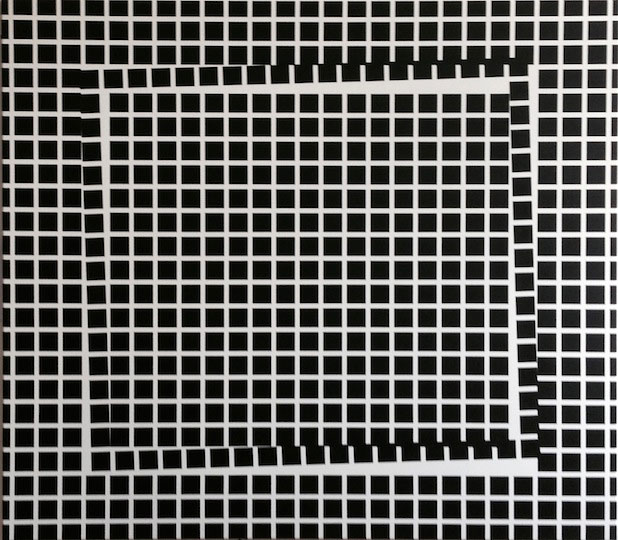STOCKER – PANE
Tel : 00 "" (0) 1 43 06 58 72
Alberta Pane gallery is delighted to present the third exhibition of the work of Italo-Austrian artist Esther Stocker at the gallery. The exhibition will associate an original site specific installation with new paintings and sculptures by the artist. We are proud as well to announce the recent release of the last artist’s catalogue, including several texts written by authors such as Monika Machnicki, Gunther Oberhollenzer and Karine Tissot, of whom we propose an extract about the latest installation by Esther Stocker at the Kunsthalle Palazzo in Liestal, Switzerland.
“I’ve been fascinated for some time by the imprecision of exactitude: for me rules and confusion are akin. They even form a single thing at times,” Esther Stocker explains.
If we consider the evolution of her output chronologically, the “thing” she is speaking of first took shape in her work in painting. [...] In Stocker’s work, there is nothing to connect with one kind of spiritualism or other, as was the case in the painting of Mondrian or Malevich, precursors in the use of the grid motif. Line in Stocker’s art is straight, black or white—in contrast with the background—more or less massive, and unvarying. Whether horizontal or vertical, it plunges from one edge of the support to the other. Crossing a few lines of the same sort, more or less broad, it divides the field of the painting into uniform sections of flat unmodulated paint. That is the underlying grid in all of Stocker’s works. And it is difficult to overestimate the leading role the grid has played in painting and in the painting of this young woman in particular, namely, of drawing attention—with a certain vigor—to the fact that we find ourselves in front of an artificial object with its own characteristics that place it apart from the world of objects. [...] In Stocker’s work, it is technically the result of a meticulous application of scotch tape—again, scotch tape, though used this time to protect the canvas and not to draw a line, as in the case of her three-dimensional installations—in a sensitive balance that combines the force of the line with a minimum of gestures, concise, thought out, and enlisted to create a powerful visual impact.
In its deployment, the grid allows the Austrian artist to explode genres. Indeed, how would it be possible to restrictively place her pictures in the register of painting or her installations in that of sculpture? She who calls herself a painter above all has in fact managed to literally quit the frame of the painting and physically enter into a dialogue with all kinds of buildings. [...] For some time now three-dimensional space has become an inescapable component of her pieces, in which the presence of a form or sign can prove to be as important and powerful as the absence of form. More complex than meets the eye, her two-color devices cantruly colonize the architecture of the venues in which they are shown. In certain situations, the artist interrupts the lines, amplifies them and deconstructs the geometrical forms that are set up on the walls, as well as the floors and ceilings. Viewers then find themselves immersed, at the center of optical illusions in three dimensions whose only function, as the example in Liestal has already made clear, is to reveal the space.
Whatever changes are made to the basic grid, they render Stocker’s pieces imperfect, like systems without logic. Those pieces are not always the result of something that is added, but also of something that is taken away. They often come across then like missing families that have apparently disappeared in succeeding layers. For example, one counts three superimposed layers of white squares in the grid decorating the Tonspur passage of Vienna’s Museumquartier before any trace of the black orthogonal lines eventually makes its way through. Fascinated by blanks which constitute gaps, openings or silences, the artist spoke about the long-term installation she recently did in Metz for the Mazelle parking garage opposite the Pompidou Center and explained that “the weft demonstrates that a structure is always something other than the sum of its parts. The illusory character of the motif should awaken the viewer’s curiosity.” [...]
In the year 1997, the artist set up a kind of alphabet. And from that initial alphabet there emerges not only a veritable vocabulary but a form of literature. This is all the more obvious in the space when the geometrical system becomes less rigid and other parameters have to be taken into account, like light or the viewer’s movements around the venue. Dictated by a more or less sustained pace, those movements indeed allow one to verify that a spatial geometry cannot be as strict as on a canvas since with movement, it is being endlessly distorted, superimposed, endlessly disappearing and springing back to life… in favor of a variable imagery.
